2024年新教材外研版七年级上册英语语法讲解+练习(形容词、人称和物主代词、There be、所有格、 频度副词)
文档属性
| 名称 | 2024年新教材外研版七年级上册英语语法讲解+练习(形容词、人称和物主代词、There be、所有格、 频度副词) |

|
|
| 格式 | pptx | ||
| 文件大小 | 10.0MB | ||
| 资源类型 | 试卷 | ||
| 版本资源 | 外研版 | ||
| 科目 | 英语 | ||
| 更新时间 | 2024-12-19 18:00:59 | ||
图片预览

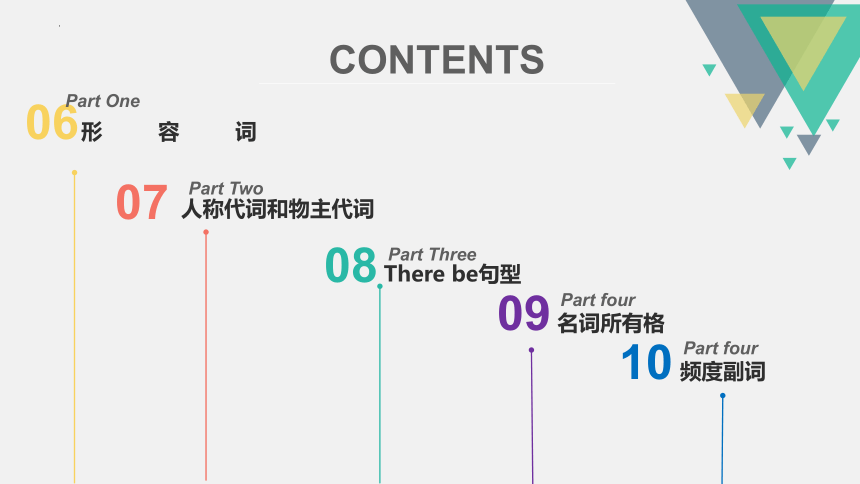
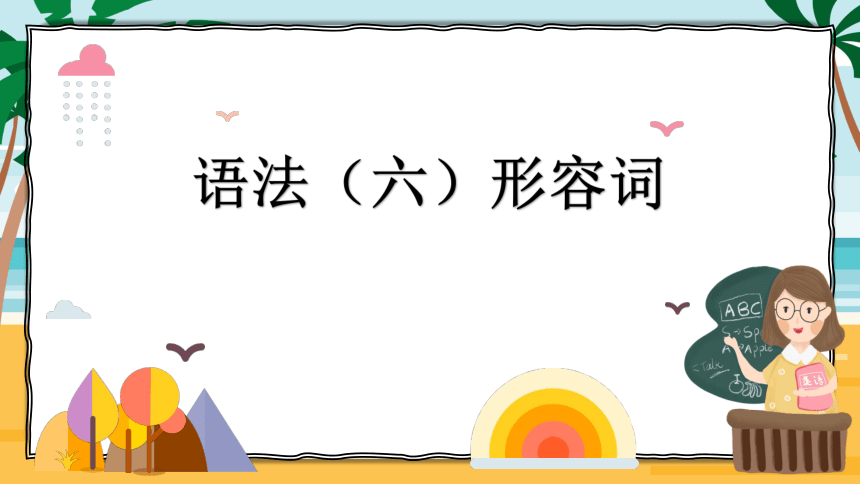
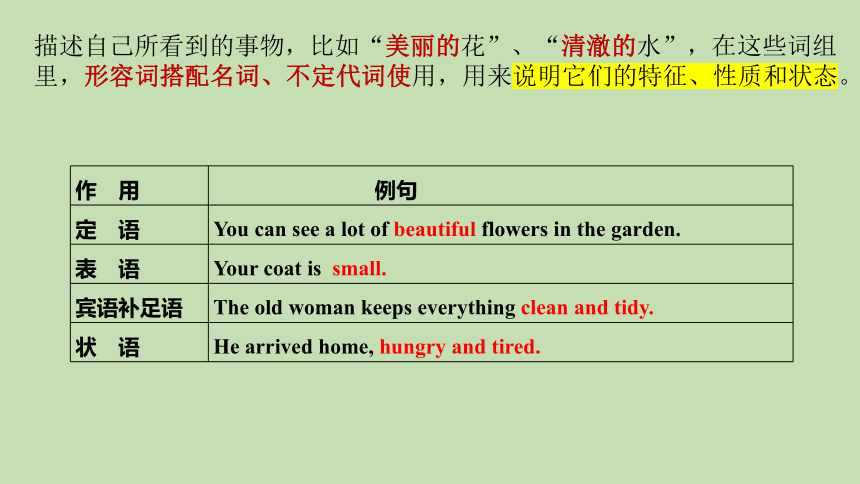
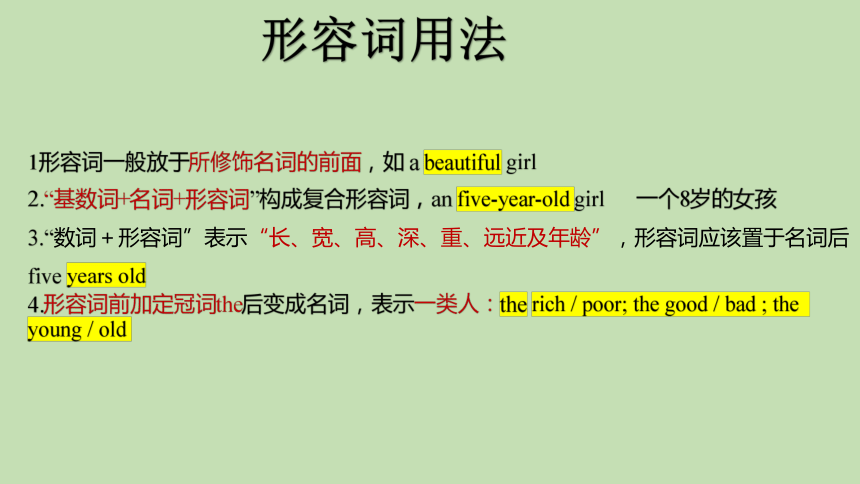
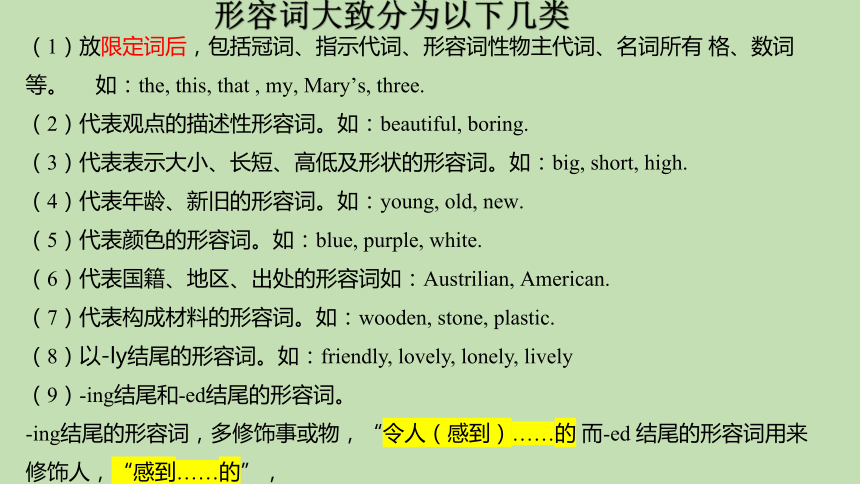
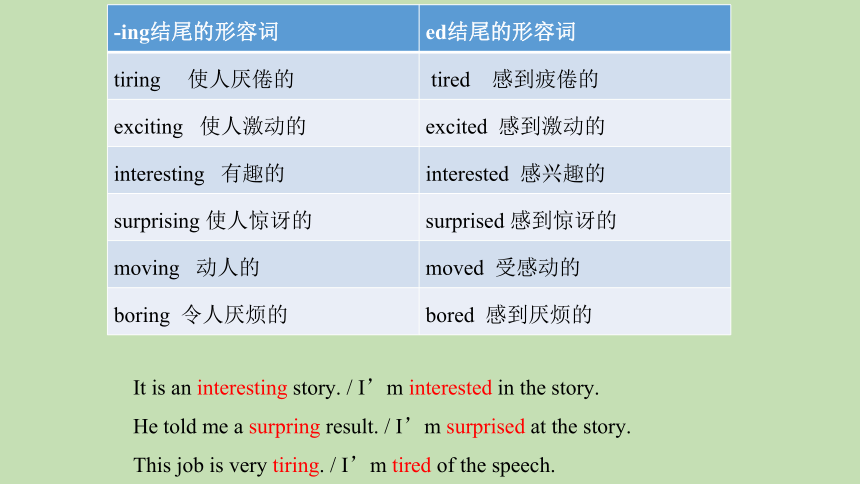
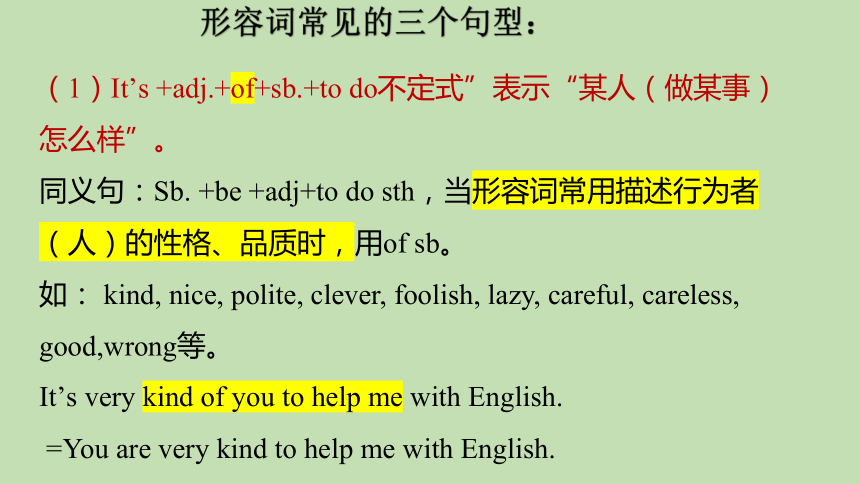

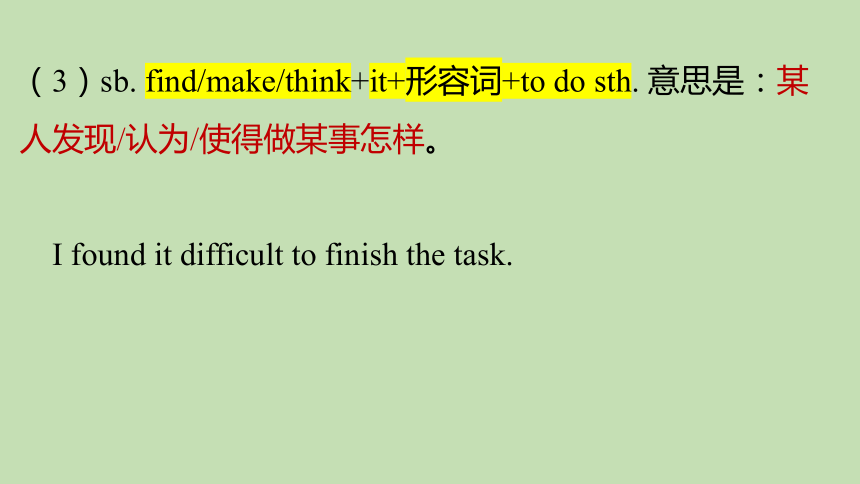
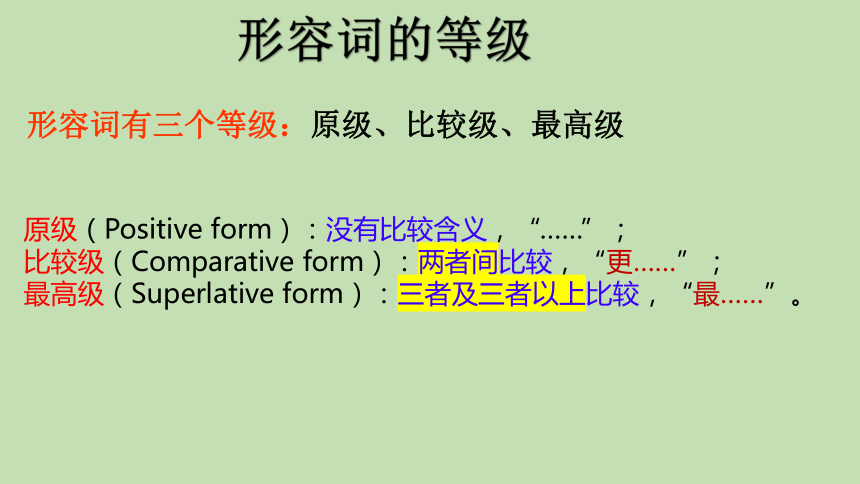
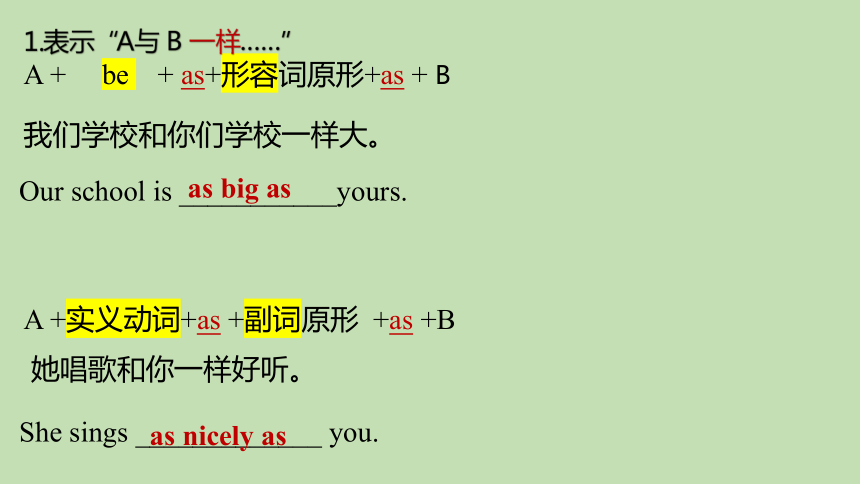
文档简介
(共54张PPT)
Review
新教材七年级上册语法讲解+练习
按照书本单元顺序,全面细致清晰
CONTENTS
06
形容词
Part One
07
人称代词和物主代词
Part Two
08
There be句型
Part Three
10
频度副词
Part four
09
名词所有格
Part four
语法(六)形容词
描述自己所看到的事物,比如“美丽的花”、“清澈的水”,在这些词组里,形容词搭配名词、不定代词使用,用来说明它们的特征、性质和状态。
作 用 例句
定 语 You can see a lot of beautiful flowers in the garden.
表 语 Your coat is small.
宾语补足语 The old woman keeps everything clean and tidy.
状 语 He arrived home, hungry and tired.
1形容词一般放于所修饰名词的前面,如 a beautiful girl
2.“基数词+名词+形容词”构成复合形容词,an five-year-old girl 一个8岁的女孩
3.“数词+形容词”表示“长、宽、高、深、重、远近及年龄”,形容词应该置于名词后 five years old
4.形容词前加定冠词the后变成名词,表示一类人:the rich / poor; the good / bad ; the young / old
形容词用法
形容词大致分为以下几类
(1)放限定词后,包括冠词、指示代词、形容词性物主代词、名词所有 格、数词等。 如:the, this, that , my, Mary’s, three.
(2)代表观点的描述性形容词。如:beautiful, boring.
(3)代表表示大小、长短、高低及形状的形容词。如:big, short, high.
(4)代表年龄、新旧的形容词。如:young, old, new.
(5)代表颜色的形容词。如:blue, purple, white.
(6)代表国籍、地区、出处的形容词如:Austrilian, American.
(7)代表构成材料的形容词。如:wooden, stone, plastic.
(8)以-ly结尾的形容词。如:friendly, lovely, lonely, lively
(9)-ing结尾和-ed结尾的形容词。
-ing结尾的形容词,多修饰事或物,“令人(感到)……的 而-ed 结尾的形容词用来修饰人,“感到……的”,
-ing结尾的形容词 ed结尾的形容词
tiring 使人厌倦的 tired 感到疲倦的
exciting 使人激动的 excited 感到激动的
interesting 有趣的 interested 感兴趣的
surprising 使人惊讶的 surprised 感到惊讶的
moving 动人的 moved 受感动的
boring 令人厌烦的 bored 感到厌烦的
It is an interesting story. / I’m interested in the story.
He told me a surpring result. / I’m surprised at the story.
This job is very tiring. / I’m tired of the speech.
形容词常见的三个句型:
(1)It’s +adj.+of+sb.+to do不定式”表示“某人(做某事)怎么样”。
同义句:Sb. +be +adj+to do sth,当形容词常用描述行为者(人)的性格、品质时,用of sb。
如: kind, nice, polite, clever, foolish, lazy, careful, careless, good,wrong等。
It’s very kind of you to help me with English.
=You are very kind to help me with English.
(2)It’s+adj.+for+sb.+to do不定式”意思是“做某事对某人来说怎么样”
同义句:To do sth is +adj for sb.
当形容词常用描述做某事性质时,用for sb。
如: safe, useful, pleasant, interesting, important, necessary, difficult, easy, hard, dangerous,等。
It’s useful for us to learn English. =To learn English is useful for us.
(3)sb. find/make/think+it+形容词+to do sth. 意思是:某人发现/认为/使得做某事怎样。
I found it difficult to finish the task.
形容词的等级
形容词有三个等级:原级、比较级、最高级
原级(Positive form):没有比较含义,“……”;
比较级(Comparative form):两者间比较,“更……”;
最高级(Superlative form):三者及三者以上比较,“最……”。
1.表示“A与 B 一样……”
A + be + as+形容词原形+as + B
A +实义动词+as +副词原形 +as +B
Our school is ___________yours.
She sings _____________ you.
我们学校和你们学校一样大。
她唱歌和你一样好听。
as big as
as nicely as
2.形容词和副词的比较级用于两者之间的比较, 表示“较…...”或“更……一些”;标志词:than (比)
3.形容词和副词的最高级用于三者或三者以上的人或物之间的比较,表示“最……”。形容词最高级前一般要加定冠词the.
标志词:in+大范围, of all, of +the+具体的数字
A
B
be
形容词比较级
than
+
+
+
+
eg. He is taller than me.
比较级 + than …
Jack is one of the tallest students in our class.
4.one of +形容词最高级+ 名词复数 表示“最… 之一”
二、比较级的用法
It's raining _____________________. 雨越下越大。
This movie gets ___________________________. 这部电影越来越受欢迎了。
1.比较级+and +比较级,该结构表示“越来越……”,
当形容词或副词为部分双音节词或多音节时,用" more and more +
形容词/副词原级"表示.
harder and harder
more and more popular
The more you eat, the fatter you will be.
2 . the +比较级, the +比较级
越……, 越……。
The______(many) friends you have, the _______(happy) you will be.
more
happier
一、比较级和最高级的构成
1. 规则变化
原级 比较级 最高级
good/well好 better best
bad/ill/badly坏 worse worst
many/ much多 more most
little少 less least
old老 older/elder oldest/eldest
far远 farther距离远 further程度深 farthest距离远furthest程度深
2. 不规则变化
1. Which do you like ______(good),apples or oranges
2. Mother is ____________ (busy)in my family.
3. Who is ______(old),Jim or Tom
4. Jack is running _______ and _________ (fast) .
5.Mo Yan is one of _______________(famous) writers in the world.
6.Which city is___________(big),Beijing, Shanghai andGuangzhou
7. Our country is becoming _____ and ___________ (beautiful).
8.Our teacher is as ______ as before.(busy).
9.In my class, Han Mei is the _________(tall) girl .
10.My brother is _______(strong) than me.
the busiest
the most famous
the biggest
faster
better
older
faster
busy
more
more beautiful
tallest
stronger
语法(七)
人称代词和物主代词
人称代词&物主代词区别方法
有“...的”,用物主代词
无“...的”,用人称代词
无名则名
动,介后用宾格
有名则形
动词前用主格
翻译
人称代词:指代“你,我,他”、“你们,我们,他们”。句子开头做主语,用主格;动词或介词后做宾语,用宾格。
人称 单数 复数 主格 宾格 主格 宾格
第一人称 I我 we
第二人称 you you
第三人称 he他 they
her it me
us
you你
you
him
she她
it它
them
物主代词:表示某人的……+名词
形容词性物主代词 一 二 三 单数
我的 你的 他的 她的 它的
复数 我们的 你们的 他/她/它们的 our
your
their
her
my
your
his
its
指示代词:this这个--these这些 that那个--those哪些
按要求写出下列词的变化形式
1. I (宾格)
2. you (形容词性物主代词)
3. he (名词性物主代词)
4. us (主格)
5. it (名词性物主代词)
6. me (名词性物主代词)
7. her (主格)
8. I (复数)
9. mine (复数)
10. hers (复数)
me
your
his
we
its
mine
she
we
ours
theirs
一、用所给词的适当形式填空:
_______ (I) pen is in the bag.
_______ (our) go to school at 7:30.
_______ (he) favorite color is yellow.
The students do ______(they) homework every evening.
My friend Jenny love to listen to ____(I) .
Jack plays soccer with _______ (he) cousin after school.
Thanks for ______ (you) help.
My
We
His
their
me
his
your
二、 用代词的适当填空。
1. __________ is my aunt. We often visit __________. ( she )
2. China is a developing country. ______is in the east of Asia. ( its )
3. What day is _______today — _______ is Thursday. (its)
4. I own a blue bike. The red one isn’t __________. ( I )
5. These new houses are so nice. _______ are very expensive.( them )
6. Jack has a dog and so have I. ____ ( he ) dog and ____ ( I ) had a fight (打架).
7. Ling Ling is a girl. ____ studies in a primary school. ( she )
8. Mike is my classmate. ____ is good at English . ( his )
She
her
It
it
It
mine
They
His
mine
She
He
语法(八)There be句型
there be表示客观“某地存在某人、某物” “某地有某人、某物”,句型的结构为“There is/are + 某物 / 某人+地点.”
There is a sofa in the sitting room.
There are twenty-two boys in our class.
There is some cheese on the plate.
客厅里有一张沙发。
我们班有22名男生。
盘子里有一些奶酪。
There______ a lamp, a clock and some books on the desk.
There _______ some pens and a ruler on the desk.
书桌上有一盏台灯,一个闹钟和一些书。
当句子的主语是由几个并列的名词构成时,动词be由第一个名词确定,即“就近原则”。
书桌上有几支笔,一把尺子。
is
are
be 动词的变化
There is + 单数可数名词/不可数名词
There are + 复数名词
There ______ a bird in the tree.
There ______ some dogs in the house.
There ______ some milk in the fridge.
There ______ a dog and 3 cats in the house.
There ______ 6 bottles and 1 cup on the table.
is
are
is
is
are
可数名词单数
可数名词复数
不可数名词
可数名词单数
可数名词复数
There be表存在
主语跟在be后边
单数/不可数用is
复数我们就用are
就近原则要牢记
01
be 动词的变化
02
时态变化
There ________a book in my bag.
There _________a book in my bag yeasterday.
is
was
There _________ forty students in our class.
There _________forty students in our school last year.
are
were
There be中的be动词有时态的变化。
找(时态提示词)
定(be动词)
划紧跟空格后的
(名词)
There be 句型变化
03
肯定句
否定句
疑问句
There are so many fans of them.
There aren’t so many fans of them.
Are there so many fans of them
变否定,很容易,
be后not莫忘记
变疑问,也不难,
把be提到there前
Yes, there are./ No, there aren’t.
It’s a beautiful Sunday morning. There 1)_______ lots of people in the park. They are playing happily. A boy is playing a guitar under a tree. He is playing wonderfully. On the square, there 2)_______ many people dancing. 3)_______ there any kids in the park Yes, they are running and playing here and there. How happy they are! There 4)_____ a lake in the park. There 5)_____ lots of fish in it. But there 6)_______ (not) any people swimming in it.
are
are
Are
is
are
aren’t
1.公园里很多树。
2.教室里有篮球吗?
3.在我的铅笔盒里有两块橡皮。
4.我家有六口人。
5.去年书架上没有英语书。
6.昨天桌子上有个苹果。
7.操场上有很多学生。
8. 杯子里还有一些水。
There are many trees in the park.
Are there any basketballs in the classroom.
There are two erasers in my pencil box.
There weren’t any English books on the shelf last year.
There was an apple on the desk.
There are many students in the playground.
There is still some water in the cup.
There are six people in my family.
中文翻译成英文
根据括号内的要求完成下列各题,每空一词(含缩略形式)。
1. Three cats and a dog are in Linda’ s house. (改为同义句)
_______ _______ three cats and a dog in Linda’ s house.
2. —Is there a pay phone near here (补全肯定答语)
—Yes, _______ _______.
3. There’ s some milk in the box. (改为一般疑问句)
_______ _______ _______ milk in the box
4. There are some banks around our school. (改为否定句)
_______ _______ _______ banks around our school.
There are
there is
Is there any
There aren’ t any
语法(九)名词所有格
定义
1. 在英语中,有些名词在词尾加-’s ,翻译为“……的”表示所有关系,这种形式称为名词的所有格
有生命的名词所有格
无生命的名词所有格
名 词所有格
Kate的猫
儿童节
我爸爸的书包
1、有生命的’ s 所有格
a.单数名词和不以 s 结尾的复数名词一般在词尾加上“ ’s”.
Kate’s cat
Children’s Day
my father’s bag
the students ’ book
b.以 s或es 结尾的复数名词在词尾只加“ ’ ”。
女孩们的书
老师们的办公室
学生们的书
the girls’ books
the teachers ’ office
人们的生活
妇女节
Mary的书
学生们的周末
女孩们的半身裙
男孩子们的足球
people’s life
Women’s Day
Mary’s book
students’ weekend
girls’ skirts
boys’ soccer
不以“s”结尾的名词,其名词所有格形式:’s
以“s”结尾的名词,其名词所有格形式:’
c. 有些表示时间、距离、国家、城镇、天体等的名词,也可以加’s 构成所有格
the nation’s young man 国家的年轻人
ten minutes’ walk 十分钟的路程
today’s homework 今天的作业
d. 表示店铺、教堂或某人的家时,名词所有格后面常常不出现它所修饰的名词。
He went to a doctor’s 他去诊所/医院了
Lucy went to her sister’s. Lucy 去他姐姐家了。
共有&不共有
如果一样东西为两人所共有,则只有在后一个名词后+’s
如果不是共有,则两个名词之后都要+’s
Mr Li is Bill and Tom’s teacher .
Bill’s and Tom’s teachers are both famous in our school.
2、无生命的名词所有格:A of+B名词,B的A
医院的名字 the name of the hospital
衣服的颜色 the colour of the clothes
教室的门 the door of the classroom
中国的地图 the map of China
3.双重名词所有格“of+’s+名词”或“of+名词性物主代词
a car of my sister’s 我姐姐的一辆车
a picture of mine 我的一张照片
Lily is a friend of ______.
A. Mary’s mother’s
B. Mary’s mother’s of
C. Mary mother’s
D. mother’s of Mary
1.This is _________(Kate)cat.It likes fish very much.
2.Frank is a friend of ________(I). He is a scientist from Canada.
3.It's about one_______ (hour) bus ride from my home to the airport.
4.The woman in a hat is _____________(Jack and John) aunt.
5.September 10th is ________________ (Teacher) Day .
6.My ______________ (mother) birthday is February 15th
7.My ___________(sister) pen is on the desk.
8.Li Ming _________(father) work in a big hospital.
9.I feel sick.I need to go to the ____________(doctor).
10.What’s the ________(girl) name She is Lisa.
Kate’s
mine
hour’s
Jack and John’s
Teachers’
mother’s
sister’s
father’s
doctor’s
girl’s
语法(十)频度副词
usually 通常
often 常常
sometimes 有时
seldom 很少
never 从未
100%
0%
always(100%)>usually(80%)>often(60%)>
sometimes(40%)>seldom(20%)>never(0%)
在英文中用来表示动作频率的词被称为“频度副词"。常见的频度副词包括: always, usually, often, sometimes, never等。
always 一直,总是
这些频度副词在句子中的位置,参考以下:
1) 在系动词之后。
例如: She is usually very busy. 她通常很忙。
2) 在助动词之后。
例如: I will never forget this holiday.
我永远不会忘记这个假期。
3) 在情态动词之后。
例如: You should always go to school on time.
你应该总是按时上学。
4) 在行为动词之前。
例如: We often go to the cinema. 我们经常去电影院看电影。
5) sometimes可放在句首。
例如: Sometimes ,she calls me.
1.I ________ (从不)go to the cinema.I only watch films at home.
2.Chlidren ________(总是) get Hongbao at spring festival.
3.Mr. Liu _________ (很少)watches TV. He thinks watching TV is a waste of time.
4.----How ________do you eat fast food ---- Twice a week.
never
always
seldom
often
连词成句
1.cooks; me; she;for;sometimes
2.grandma;often;watched;I ; cook.
3.never;anything;myself;I ;cooked
4.family;have;my ;at ;pork meatball;always ;the Spring Festival.
Sometimes she cooks for me.
I often watched Gramma cook.
I never cooked anything myself.
My family always have pork meatball at the Spring Festival.
THANK
YOU!
https://www.21cnjy.com/help/help_extract.php
Review
新教材七年级上册语法讲解+练习
按照书本单元顺序,全面细致清晰
CONTENTS
06
形容词
Part One
07
人称代词和物主代词
Part Two
08
There be句型
Part Three
10
频度副词
Part four
09
名词所有格
Part four
语法(六)形容词
描述自己所看到的事物,比如“美丽的花”、“清澈的水”,在这些词组里,形容词搭配名词、不定代词使用,用来说明它们的特征、性质和状态。
作 用 例句
定 语 You can see a lot of beautiful flowers in the garden.
表 语 Your coat is small.
宾语补足语 The old woman keeps everything clean and tidy.
状 语 He arrived home, hungry and tired.
1形容词一般放于所修饰名词的前面,如 a beautiful girl
2.“基数词+名词+形容词”构成复合形容词,an five-year-old girl 一个8岁的女孩
3.“数词+形容词”表示“长、宽、高、深、重、远近及年龄”,形容词应该置于名词后 five years old
4.形容词前加定冠词the后变成名词,表示一类人:the rich / poor; the good / bad ; the young / old
形容词用法
形容词大致分为以下几类
(1)放限定词后,包括冠词、指示代词、形容词性物主代词、名词所有 格、数词等。 如:the, this, that , my, Mary’s, three.
(2)代表观点的描述性形容词。如:beautiful, boring.
(3)代表表示大小、长短、高低及形状的形容词。如:big, short, high.
(4)代表年龄、新旧的形容词。如:young, old, new.
(5)代表颜色的形容词。如:blue, purple, white.
(6)代表国籍、地区、出处的形容词如:Austrilian, American.
(7)代表构成材料的形容词。如:wooden, stone, plastic.
(8)以-ly结尾的形容词。如:friendly, lovely, lonely, lively
(9)-ing结尾和-ed结尾的形容词。
-ing结尾的形容词,多修饰事或物,“令人(感到)……的 而-ed 结尾的形容词用来修饰人,“感到……的”,
-ing结尾的形容词 ed结尾的形容词
tiring 使人厌倦的 tired 感到疲倦的
exciting 使人激动的 excited 感到激动的
interesting 有趣的 interested 感兴趣的
surprising 使人惊讶的 surprised 感到惊讶的
moving 动人的 moved 受感动的
boring 令人厌烦的 bored 感到厌烦的
It is an interesting story. / I’m interested in the story.
He told me a surpring result. / I’m surprised at the story.
This job is very tiring. / I’m tired of the speech.
形容词常见的三个句型:
(1)It’s +adj.+of+sb.+to do不定式”表示“某人(做某事)怎么样”。
同义句:Sb. +be +adj+to do sth,当形容词常用描述行为者(人)的性格、品质时,用of sb。
如: kind, nice, polite, clever, foolish, lazy, careful, careless, good,wrong等。
It’s very kind of you to help me with English.
=You are very kind to help me with English.
(2)It’s+adj.+for+sb.+to do不定式”意思是“做某事对某人来说怎么样”
同义句:To do sth is +adj for sb.
当形容词常用描述做某事性质时,用for sb。
如: safe, useful, pleasant, interesting, important, necessary, difficult, easy, hard, dangerous,等。
It’s useful for us to learn English. =To learn English is useful for us.
(3)sb. find/make/think+it+形容词+to do sth. 意思是:某人发现/认为/使得做某事怎样。
I found it difficult to finish the task.
形容词的等级
形容词有三个等级:原级、比较级、最高级
原级(Positive form):没有比较含义,“……”;
比较级(Comparative form):两者间比较,“更……”;
最高级(Superlative form):三者及三者以上比较,“最……”。
1.表示“A与 B 一样……”
A + be + as+形容词原形+as + B
A +实义动词+as +副词原形 +as +B
Our school is ___________yours.
She sings _____________ you.
我们学校和你们学校一样大。
她唱歌和你一样好听。
as big as
as nicely as
2.形容词和副词的比较级用于两者之间的比较, 表示“较…...”或“更……一些”;标志词:than (比)
3.形容词和副词的最高级用于三者或三者以上的人或物之间的比较,表示“最……”。形容词最高级前一般要加定冠词the.
标志词:in+大范围, of all, of +the+具体的数字
A
B
be
形容词比较级
than
+
+
+
+
eg. He is taller than me.
比较级 + than …
Jack is one of the tallest students in our class.
4.one of +形容词最高级+ 名词复数 表示“最… 之一”
二、比较级的用法
It's raining _____________________. 雨越下越大。
This movie gets ___________________________. 这部电影越来越受欢迎了。
1.比较级+and +比较级,该结构表示“越来越……”,
当形容词或副词为部分双音节词或多音节时,用" more and more +
形容词/副词原级"表示.
harder and harder
more and more popular
The more you eat, the fatter you will be.
2 . the +比较级, the +比较级
越……, 越……。
The______(many) friends you have, the _______(happy) you will be.
more
happier
一、比较级和最高级的构成
1. 规则变化
原级 比较级 最高级
good/well好 better best
bad/ill/badly坏 worse worst
many/ much多 more most
little少 less least
old老 older/elder oldest/eldest
far远 farther距离远 further程度深 farthest距离远furthest程度深
2. 不规则变化
1. Which do you like ______(good),apples or oranges
2. Mother is ____________ (busy)in my family.
3. Who is ______(old),Jim or Tom
4. Jack is running _______ and _________ (fast) .
5.Mo Yan is one of _______________(famous) writers in the world.
6.Which city is___________(big),Beijing, Shanghai andGuangzhou
7. Our country is becoming _____ and ___________ (beautiful).
8.Our teacher is as ______ as before.(busy).
9.In my class, Han Mei is the _________(tall) girl .
10.My brother is _______(strong) than me.
the busiest
the most famous
the biggest
faster
better
older
faster
busy
more
more beautiful
tallest
stronger
语法(七)
人称代词和物主代词
人称代词&物主代词区别方法
有“...的”,用物主代词
无“...的”,用人称代词
无名则名
动,介后用宾格
有名则形
动词前用主格
翻译
人称代词:指代“你,我,他”、“你们,我们,他们”。句子开头做主语,用主格;动词或介词后做宾语,用宾格。
人称 单数 复数 主格 宾格 主格 宾格
第一人称 I我 we
第二人称 you you
第三人称 he他 they
her it me
us
you你
you
him
she她
it它
them
物主代词:表示某人的……+名词
形容词性物主代词 一 二 三 单数
我的 你的 他的 她的 它的
复数 我们的 你们的 他/她/它们的 our
your
their
her
my
your
his
its
指示代词:this这个--these这些 that那个--those哪些
按要求写出下列词的变化形式
1. I (宾格)
2. you (形容词性物主代词)
3. he (名词性物主代词)
4. us (主格)
5. it (名词性物主代词)
6. me (名词性物主代词)
7. her (主格)
8. I (复数)
9. mine (复数)
10. hers (复数)
me
your
his
we
its
mine
she
we
ours
theirs
一、用所给词的适当形式填空:
_______ (I) pen is in the bag.
_______ (our) go to school at 7:30.
_______ (he) favorite color is yellow.
The students do ______(they) homework every evening.
My friend Jenny love to listen to ____(I) .
Jack plays soccer with _______ (he) cousin after school.
Thanks for ______ (you) help.
My
We
His
their
me
his
your
二、 用代词的适当填空。
1. __________ is my aunt. We often visit __________. ( she )
2. China is a developing country. ______is in the east of Asia. ( its )
3. What day is _______today — _______ is Thursday. (its)
4. I own a blue bike. The red one isn’t __________. ( I )
5. These new houses are so nice. _______ are very expensive.( them )
6. Jack has a dog and so have I. ____ ( he ) dog and ____ ( I ) had a fight (打架).
7. Ling Ling is a girl. ____ studies in a primary school. ( she )
8. Mike is my classmate. ____ is good at English . ( his )
She
her
It
it
It
mine
They
His
mine
She
He
语法(八)There be句型
there be表示客观“某地存在某人、某物” “某地有某人、某物”,句型的结构为“There is/are + 某物 / 某人+地点.”
There is a sofa in the sitting room.
There are twenty-two boys in our class.
There is some cheese on the plate.
客厅里有一张沙发。
我们班有22名男生。
盘子里有一些奶酪。
There______ a lamp, a clock and some books on the desk.
There _______ some pens and a ruler on the desk.
书桌上有一盏台灯,一个闹钟和一些书。
当句子的主语是由几个并列的名词构成时,动词be由第一个名词确定,即“就近原则”。
书桌上有几支笔,一把尺子。
is
are
be 动词的变化
There is + 单数可数名词/不可数名词
There are + 复数名词
There ______ a bird in the tree.
There ______ some dogs in the house.
There ______ some milk in the fridge.
There ______ a dog and 3 cats in the house.
There ______ 6 bottles and 1 cup on the table.
is
are
is
is
are
可数名词单数
可数名词复数
不可数名词
可数名词单数
可数名词复数
There be表存在
主语跟在be后边
单数/不可数用is
复数我们就用are
就近原则要牢记
01
be 动词的变化
02
时态变化
There ________a book in my bag.
There _________a book in my bag yeasterday.
is
was
There _________ forty students in our class.
There _________forty students in our school last year.
are
were
There be中的be动词有时态的变化。
找(时态提示词)
定(be动词)
划紧跟空格后的
(名词)
There be 句型变化
03
肯定句
否定句
疑问句
There are so many fans of them.
There aren’t so many fans of them.
Are there so many fans of them
变否定,很容易,
be后not莫忘记
变疑问,也不难,
把be提到there前
Yes, there are./ No, there aren’t.
It’s a beautiful Sunday morning. There 1)_______ lots of people in the park. They are playing happily. A boy is playing a guitar under a tree. He is playing wonderfully. On the square, there 2)_______ many people dancing. 3)_______ there any kids in the park Yes, they are running and playing here and there. How happy they are! There 4)_____ a lake in the park. There 5)_____ lots of fish in it. But there 6)_______ (not) any people swimming in it.
are
are
Are
is
are
aren’t
1.公园里很多树。
2.教室里有篮球吗?
3.在我的铅笔盒里有两块橡皮。
4.我家有六口人。
5.去年书架上没有英语书。
6.昨天桌子上有个苹果。
7.操场上有很多学生。
8. 杯子里还有一些水。
There are many trees in the park.
Are there any basketballs in the classroom.
There are two erasers in my pencil box.
There weren’t any English books on the shelf last year.
There was an apple on the desk.
There are many students in the playground.
There is still some water in the cup.
There are six people in my family.
中文翻译成英文
根据括号内的要求完成下列各题,每空一词(含缩略形式)。
1. Three cats and a dog are in Linda’ s house. (改为同义句)
_______ _______ three cats and a dog in Linda’ s house.
2. —Is there a pay phone near here (补全肯定答语)
—Yes, _______ _______.
3. There’ s some milk in the box. (改为一般疑问句)
_______ _______ _______ milk in the box
4. There are some banks around our school. (改为否定句)
_______ _______ _______ banks around our school.
There are
there is
Is there any
There aren’ t any
语法(九)名词所有格
定义
1. 在英语中,有些名词在词尾加-’s ,翻译为“……的”表示所有关系,这种形式称为名词的所有格
有生命的名词所有格
无生命的名词所有格
名 词所有格
Kate的猫
儿童节
我爸爸的书包
1、有生命的’ s 所有格
a.单数名词和不以 s 结尾的复数名词一般在词尾加上“ ’s”.
Kate’s cat
Children’s Day
my father’s bag
the students ’ book
b.以 s或es 结尾的复数名词在词尾只加“ ’ ”。
女孩们的书
老师们的办公室
学生们的书
the girls’ books
the teachers ’ office
人们的生活
妇女节
Mary的书
学生们的周末
女孩们的半身裙
男孩子们的足球
people’s life
Women’s Day
Mary’s book
students’ weekend
girls’ skirts
boys’ soccer
不以“s”结尾的名词,其名词所有格形式:’s
以“s”结尾的名词,其名词所有格形式:’
c. 有些表示时间、距离、国家、城镇、天体等的名词,也可以加’s 构成所有格
the nation’s young man 国家的年轻人
ten minutes’ walk 十分钟的路程
today’s homework 今天的作业
d. 表示店铺、教堂或某人的家时,名词所有格后面常常不出现它所修饰的名词。
He went to a doctor’s 他去诊所/医院了
Lucy went to her sister’s. Lucy 去他姐姐家了。
共有&不共有
如果一样东西为两人所共有,则只有在后一个名词后+’s
如果不是共有,则两个名词之后都要+’s
Mr Li is Bill and Tom’s teacher .
Bill’s and Tom’s teachers are both famous in our school.
2、无生命的名词所有格:A of+B名词,B的A
医院的名字 the name of the hospital
衣服的颜色 the colour of the clothes
教室的门 the door of the classroom
中国的地图 the map of China
3.双重名词所有格“of+’s+名词”或“of+名词性物主代词
a car of my sister’s 我姐姐的一辆车
a picture of mine 我的一张照片
Lily is a friend of ______.
A. Mary’s mother’s
B. Mary’s mother’s of
C. Mary mother’s
D. mother’s of Mary
1.This is _________(Kate)cat.It likes fish very much.
2.Frank is a friend of ________(I). He is a scientist from Canada.
3.It's about one_______ (hour) bus ride from my home to the airport.
4.The woman in a hat is _____________(Jack and John) aunt.
5.September 10th is ________________ (Teacher) Day .
6.My ______________ (mother) birthday is February 15th
7.My ___________(sister) pen is on the desk.
8.Li Ming _________(father) work in a big hospital.
9.I feel sick.I need to go to the ____________(doctor).
10.What’s the ________(girl) name She is Lisa.
Kate’s
mine
hour’s
Jack and John’s
Teachers’
mother’s
sister’s
father’s
doctor’s
girl’s
语法(十)频度副词
usually 通常
often 常常
sometimes 有时
seldom 很少
never 从未
100%
0%
always(100%)>usually(80%)>often(60%)>
sometimes(40%)>seldom(20%)>never(0%)
在英文中用来表示动作频率的词被称为“频度副词"。常见的频度副词包括: always, usually, often, sometimes, never等。
always 一直,总是
这些频度副词在句子中的位置,参考以下:
1) 在系动词之后。
例如: She is usually very busy. 她通常很忙。
2) 在助动词之后。
例如: I will never forget this holiday.
我永远不会忘记这个假期。
3) 在情态动词之后。
例如: You should always go to school on time.
你应该总是按时上学。
4) 在行为动词之前。
例如: We often go to the cinema. 我们经常去电影院看电影。
5) sometimes可放在句首。
例如: Sometimes ,she calls me.
1.I ________ (从不)go to the cinema.I only watch films at home.
2.Chlidren ________(总是) get Hongbao at spring festival.
3.Mr. Liu _________ (很少)watches TV. He thinks watching TV is a waste of time.
4.----How ________do you eat fast food ---- Twice a week.
never
always
seldom
often
连词成句
1.cooks; me; she;for;sometimes
2.grandma;often;watched;I ; cook.
3.never;anything;myself;I ;cooked
4.family;have;my ;at ;pork meatball;always ;the Spring Festival.
Sometimes she cooks for me.
I often watched Gramma cook.
I never cooked anything myself.
My family always have pork meatball at the Spring Festival.
THANK
YOU!
https://www.21cnjy.com/help/help_extract.php
同课章节目录
